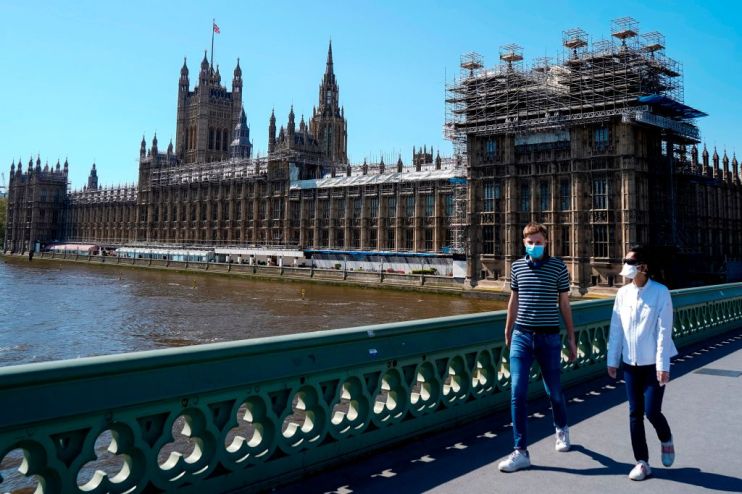Unemployment rate set to surge in UK coronavirus lockdown

The UK unemployment rate is set to rocket amid the coronavirus lockdown, economists warned today as data showed employment at a record high before March.
But job vacancies sank by 52,000 year on year to 795,000 for the first three months of 2020, the Office for National Statistics (ONS) said.
UK unemployment also inched up by 22,000 to 1.36m in the three months to February ahead of March’s coronavirus lockdown.
That saw the UK unemployment rate tick up to four per cent, a small increase on January’s 3.9 per cent rate.
UK employment rate hits record high before coronavirus lockdown
Economists had feared a huge 170,000 increase in UK unemployment for March, but the number rose only by 12,100.
In fact the UK employment rate was at a record high of 76.6 per cent before the coronavirus lockdown. That was up from 76.4 per cent in the previous quarter.
“Our final data wholly from before the coronavirus restrictions were in place showed the labour market was very robust in the three months to February,” David Freeman, ONS head of labour market statistics, said.
But while the ONS hailed a strong labour market, it warned of a “softening” picture for March.
And experts warned the UK labour market faces a tumultuous April following measures to contain the spread of coronavirus.
KPMG warned the latest figures “mask the extent of the rise in unemployment” expected in 2020.
Yael Selfin, chief economist for KPMG, said early figures for March underline how badly coronavirus will affect the UK jobs market.
“Early figures for March underscore the impact Covid-19 is likely to have on the labour market.
UK unemployment to rocket in lockdown
“We estimate that as many as 13m jobs are in sectors highly affected by the lockdown, representing 36 per cent of all jobs in the UK,” she said.
“[This] could see unemployment rising to just under nine per cent during the lockdown period.”
Capital Economics agreed with this view, estimating the current four per cent UK unemployment rate could hit nine per cent. And it also predicted household income could slump 10 per cent.
Capital Economics’ chief UK economist, Paul Dales, warned March’s “small crack… may soon turn into a chasm”.
He pointed to a fall in employment numbers of 17,500 for March, saying: “That’s not a big fall, but as it relates to the average number of people paid to work in March it would have been supported by the normal two weeks at the start of March.
“It suggests that [the ONS’] labour force survey employment will soon slow.”
“We think that employment will soon plunge by about five per cent,” Dales concluded.
Employment minister Mims Davies said today’s UK employment data was already outdated, but argued the unemployment rate show the economy has a robust underpinning.
“In the midst of the worst public health emergency in our lifetimes, today’s employment figures have already been overtaken by current events – and we’re doing all we can to help families make ends meet,” she said.
“But the statistics – including a four per cent unemployment rate – do serve as an important reminder of the strong foundations we have built as we look to withstand impact on the global economy.”
End of furlough could worsen UK unemployment
That is despite the government’s furlough scheme opening yesterday that has so far guaranteed wages for 1m workers.
“An additional spike in unemployment after the lockdown also seems likely, once government support via the Job Retention Scheme ends,” Selfin added.
“The rise in unemployment is expected to be proportionally larger than in past recessions owing to the severity of the crisis. However, a relatively faster recovery should also see unemployment falling more quickly this time.”
Howard Archer, chief economic adviser to the EY Item Club, said the data showed that the UK jobs market took only a “modest” hit in March.
“Indeed, the reported deterioration was markedly less than had been expected given the reports of many workers signing on to receive benefits,” he said.
However, Archer also warned of a “substantial pick-up” in workers claiming benefits since the lockdown began on 23 March.
And while the labour market was holding up well in February after December’s election, UK job vacancies fell to 795,000 in the three months to March.
That is the lowest number since late 2017, and down from 817,000 in the three months to February.
UK jobs market ‘faces chaos’ over coronavirus
April’s figures are expected to lay bare the scale of the economic hit since the coronavirus lockdown began.
“Coronavirus has wreaked havoc on the jobs market, which was turned on its head in only a few short weeks after being in relatively rude health heading into March,” Jack Kennedy, economist at the global job site Indeed, said.
The recruiter has seen UK job vacancies plunge 48 per cent. Retailers closed for the coronavirus lockdown including those in beauty, food preparation, hospitality and travel were worst hit, Indeed said.
“These numbers point towards the UK entering a deep slowdown and with millions of people furloughed or losing their jobs,” Kennedy added.
“The question is how quickly people will be able to return to their jobs or find new work when the economy reopens.”
Wage growth falls in face of coronavirus lockdown
Meanwhile, wage growth also fell before the coronavirus lockdown began. It slipped from 3.1 per cent to 2.8 per cent for the three months to February.
Spreadex financial analyst Connor Campbell said this painted “an ominous picture” of the UK jobs market before coronavirus.